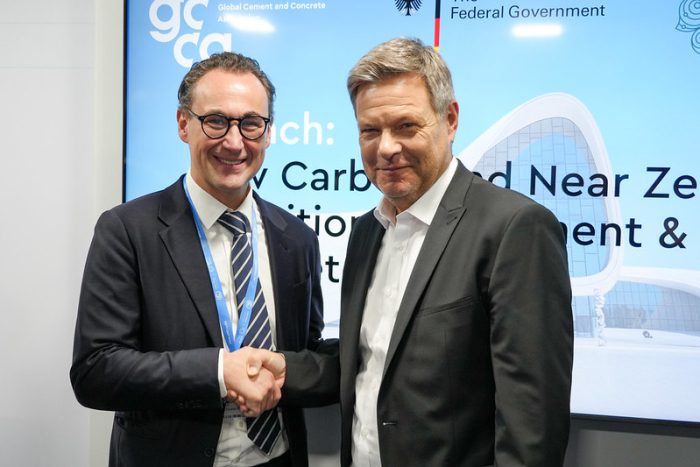18 November 2024
COP29: INTERNATIONAL DEFINITIONS FOR LOW CARBON CEMENT AND CONCRETE LAUNCHED TO FAST-TRACK GREEN PROCUREMENT OF ESSENTIAL BUILDING MATERIALS
- International definitions for low carbon cement and concrete launched at COP29 with the German Vice Chancellor
- The definitions will bring transparency and trust in the markets and help governments and businesses identify and buy green cement and concrete
- Stimulation of demand for low-carbon cement and concrete products through public and private procurement is a key lever for accelerating decarbonisation
The Global Cement and Concrete Association – GCCA has launched its international definitions for low carbon cement and concrete. The definitions are seen as crucial to providing a key reference point for anyone that wants to be able to identify and buy green cement and concrete across the world.
German Vice Chancellor and Federal Minister for Economic Affairs and Climate Action, Robert Habeck, regarding the launch at COP29:
“This is a big step forward towards delivering a greener built environment and a greener global economy. Lead markets for low carbon basic materials are an important component of the policy landscape to support decarbonisation of sectors such as cement and concrete. During the German G7 Presidency the Energy and Climate Ministers agreed on the IEA definitions being a robust starting point for the work internationally. We are delighted that this work has been built upon by the GCCA to publish low carbon and near zero definitions for concrete products.
“As co-chair of the International Climate Club initiative with Chile, we continue to facilitate multilateral collaboration and alignment on industrial decarbonization.”

Thomas Guillot, Chief Executive of the GCCA, whose members represent 80% of cement production capacity outside of China, as well as a number of leading Chinese manufacturers, said: “Concrete and its key binding ingredient cement are the most used materials on the planet after water and essential to the modern world – for delivering vital infrastructure, housing, cities and resilient communities.
“Building on our net zero commitment this is an important advancement on our journey towards net zero. We now call on policymakers, governments and the private sector to procure green cement and concrete and provide the key signals to our sector to accelerate decarbonisation. “
The industry, in consultation with a wide range of stakeholders along the value chain including governments and organisations such as the IEA, Climate Club and Clean Energy Ministerial Industrial Deep Decarbonisation Initiative facilitated by UNIDO, have evolved and refined definitions for green concrete that are global and also customisable to local practice whilst retaining international consistency and comparability. The definitions use the environmental product declaration (EPD) accounting method that is well established in the construction value chain for products, particularly cement and concrete.
GCCA used the 2022 work by IEA for G7 on cement production as a robust starting point and have been developed with public and private procurement in mind. The definitions are designed to be used with local benchmarks and targets to reflect different challenges,opportunities and rate of decarbonisation.
Low carbon procurement of projects and products is a key driver for decarbonisation of the built environment.
Notes to editors..
Environmental Product Declarations
Environmental Product Declarations (EPDs) are the preferred method by the design and construction value chain for measuring a product’s carbon footprint in low-carbon procurement because they offer established standards that are consistent across construction materials and enable comparison between functionally equivalent products. With a global infrastructure for creating and verifying EPDs, they provide a consistent and reliable approach. Each EPD includes a Global Warming Potential (GWP) indicator, making carbon footprint assessment straightforward. Additionally, construction professionals are more familiar with EPDs than other methods, and the transparency provided by EPD standards and Product Category Rules (PCRs) ensures clear definitions of environmental impacts throughout a product’s life cycle.
About the GCCA
The GCCA and its member companies, who operate in almost every country across the planet, have committed to reducing and ultimately eliminating CO2 emissions in concrete, which currently account for around 7% globally, through implementation of the GCCA’s Concrete Future 2050 Net Zero Roadmap – the first heavy industry to set out such a detailed plan. Together, the GCCA is committed to building a bright, resilient and sustainable concrete future for the industry and for the world.